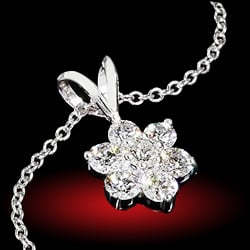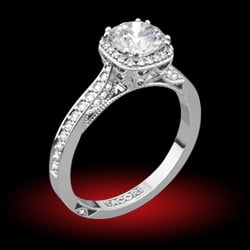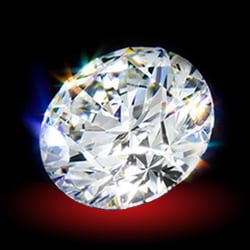You are using an out of date browser. It may not display this or other websites correctly.
You should upgrade or use an alternative browser.
You should upgrade or use an alternative browser.
Cushion fans, does smaller size bother you?
- Thread starter brina_ca
- Start date
LGK
Ideal_Rock
- Joined
- Nov 27, 2007
- Messages
- 2,975
Hm. I honestly think that the "smallness" of fancies is a bit overstated sometimes. I mean, I have a 1.5ct AVC, and a 1.22 ct OEC (it faces up exactly like a round brilliant of the same size, ~7mm) and they technically are about the same face up size. But that doesnt take into account the corners, which make the cushion visually look a bit bigger than the actual measurements suggest. So honestly I don't find that a cushion really appears THAT much smaller than a round- a little bit, but not hugely. And a cushion with killer light return? Will look bigger than most diamonds you see out there of similar size, since excellent cut anything is a rarity IRL.
Frankly I'd get what you like, but if you go with a place with a good trade up policy like GOG, all the better- you can swap it out later if you find it really is too small looking. And maybe go with a simple solitaire setting so you don't invest a ton of money in the setting if you aren't 100% sure on the stone.
Frankly I'd get what you like, but if you go with a place with a good trade up policy like GOG, all the better- you can swap it out later if you find it really is too small looking. And maybe go with a simple solitaire setting so you don't invest a ton of money in the setting if you aren't 100% sure on the stone.
iota15
Brilliant_Rock
- Joined
- Mar 19, 2010
- Messages
- 1,278
I was concerned - but, cushions face up all sorts of different sizes. Some are bigger than RB, and some are smaller (really!).
For me, I picked a cushion that has the same face-up surface area as a RB of the same weight. I determine face-up surface area by multiplying the length and width of a cushion (with maybe minus 5% if it's quite a rounded cushion). For a round brilliant, I take half of the diameter of an ideal RB, multiply it by itself then multiply it by 3.14 - so the formula is radius x radius x 3.14.
I could have picked a larger face-up cushion. With the stones available to me at the time, I couldn't find one significantly larger without sacrificing it's light performance to an unsuitable level for me. (Although I heavily considered a 2.5 ct radiant that faced-up quite a bit larger than most 3 ct rounds.... hmmm... still thinking about that one. sorta. lol.)
I don't know what a 1 ct round's face-up area is but the cushion you are looking at has about 34.8 sq mm's of surface area.
For me, I picked a cushion that has the same face-up surface area as a RB of the same weight. I determine face-up surface area by multiplying the length and width of a cushion (with maybe minus 5% if it's quite a rounded cushion). For a round brilliant, I take half of the diameter of an ideal RB, multiply it by itself then multiply it by 3.14 - so the formula is radius x radius x 3.14.
I could have picked a larger face-up cushion. With the stones available to me at the time, I couldn't find one significantly larger without sacrificing it's light performance to an unsuitable level for me. (Although I heavily considered a 2.5 ct radiant that faced-up quite a bit larger than most 3 ct rounds.... hmmm... still thinking about that one. sorta. lol.)
I don't know what a 1 ct round's face-up area is but the cushion you are looking at has about 34.8 sq mm's of surface area.
iota15
Brilliant_Rock
- Joined
- Mar 19, 2010
- Messages
- 1,278
Okay, I took a quick look at 1 ct round brilliants through the PS engine. A well cut 1 ct RB seems to have about a 6.42 diameter (yes, some are a bit bigger, but some are a bit smaller). This gives me a surface area of 32.35.
This means the cushion you are looking is about 2 square mm's LARGER than a well-cut round brilliant (that's about 6% larger - and yes, I like playing around with a calculator). Sounds more than okie dokie to me if it's a great performing cushion. Do you have an Aset image?
This means the cushion you are looking is about 2 square mm's LARGER than a well-cut round brilliant (that's about 6% larger - and yes, I like playing around with a calculator). Sounds more than okie dokie to me if it's a great performing cushion. Do you have an Aset image?
LGK|1302739330|2895469 said:Hm. I honestly think that the "smallness" of fancies is a bit overstated sometimes. I mean, I have a 1.5ct AVC, and a 1.22 ct OEC (it faces up exactly like a round brilliant of the same size, ~7mm) and they technically are about the same face up size. But that doesnt take into account the corners, which make the cushion visually look a bit bigger than the actual measurements suggest. So honestly I don't find that a cushion really appears THAT much smaller than a round- a little bit, but not hugely. And a cushion with killer light return? Will look bigger than most diamonds you see out there of similar size, since excellent cut anything is a rarity IRL.
Frankly I'd get what you like, but if you go with a place with a good trade up policy like GOG, all the better- you can swap it out later if you find it really is too small looking. And maybe go with a simple solitaire setting so you don't invest a ton of money in the setting if you aren't 100% sure on the stone.
Thanks, LGK
Woow, I do love OEC, the whole stone likes a flower, soo unique
iota15|1302741114|2895496 said:Okay, I took a quick look at 1 ct round brilliants through the PS engine. A well cut 1 ct RB seems to have about a 6.42 diameter (yes, some are a bit bigger, but some are a bit smaller). This gives me a surface area of 32.35.
This means the cushion you are looking is about 2 square mm's LARGER than a well-cut round brilliant (that's about 6% larger - and yes, I like playing around with a calculator). Sounds more than okie dokie to me if it's a great performing cushion. Do you have an Aset image?
Interesting! I was just a little bit upset for the cushion size and your opinions is totally make me happy
Anyway, please take a look of the links, the second image is the diamond I am looking at
[URL='https://www.pricescope.com/community/threads/newbie-needs-help-which-one-looks-better-opinions-pls.159224/']https://www.pricescope.com/community/threads/newbie-needs-help-which-one-looks-better-opinions-pls.159224/[/URL]
[URL='https://www.pricescope.com/community/threads/determine-a-cut-of-cushion-deep-or-shallow.159320/']https://www.pricescope.com/community/threads/determine-a-cut-of-cushion-deep-or-shallow.159320/[/URL]
iota15
Brilliant_Rock
- Joined
- Mar 19, 2010
- Messages
- 1,278
Someone mentioned 1 ct RB's can be 6.45 - that's a surface area of 33.16. Your stone is still slightly bigger, surface-area-wise. I would consider it a wash.
I commented on the Aset image of the second stone (as well as the third). I think it has the best of the three. Plus, you liked the "flower-ness" of the maltese cross (the four-main facets in the center). It would be a "go" for me.
I commented on the Aset image of the second stone (as well as the third). I think it has the best of the three. Plus, you liked the "flower-ness" of the maltese cross (the four-main facets in the center). It would be a "go" for me.
CharmyPoo
Ideal_Rock
- Joined
- Dec 10, 2004
- Messages
- 7,007
HopeDream
Ideal_Rock
- Joined
- Mar 14, 2009
- Messages
- 2,146
I have a .77ct avc (5.39mm x 5.48mm), but because I have a small finger size (4) my stone still has some impact, and is mistaken for a 1ct by the untrained eye.
It's all about proportional finger coverage: https://www.pricescope.com/communit...izes-and-percentage-of-finger-coverage.64644/
It's all about proportional finger coverage: https://www.pricescope.com/communit...izes-and-percentage-of-finger-coverage.64644/
HopeDream|1302771736|2895710 said:I have a .77ct avc (5.39mm x 5.48mm), but because I have a small finger size (4) my stone still has some impact, and is mistaken for a 1ct by the untrained eye.
It's all about proportional finger coverage: https://www.pricescope.com/communit...izes-and-percentage-of-finger-coverage.64644/
Thanks hopedream, The chart is useful....I wish I were sz 4 finger...
Sparklelu
Brilliant_Rock
- Joined
- Jul 2, 2010
- Messages
- 1,036
IOTA... Thank you for this handy little conversion thing!!!iota15|1302740483|2895484 said:I was concerned - but, cushions face up all sorts of different sizes. Some are bigger than RB, and some are smaller (really!).
For me, I picked a cushion that has the same face-up surface area as a RB of the same weight. I determine face-up surface area by multiplying the length and width of a cushion (with maybe minus 5% if it's quite a rounded cushion). For a round brilliant, I take half of the diameter of an ideal RB, multiply it by itself then multiply it by 3.14 - so the formula is radius x radius x 3.14.
I could have picked a larger face-up cushion. With the stones available to me at the time, I couldn't find one significantly larger without sacrificing it's light performance to an unsuitable level for me. (Although I heavily considered a 2.5 ct radiant that faced-up quite a bit larger than most 3 ct rounds.... hmmm... still thinking about that one. sorta. lol.)
I don't know what a 1 ct round's face-up area is but the cushion you are looking at has about 34.8 sq mm's of surface area.
I am craving an AVC but silly me does fret over the "cushions are smaller thinking" I played around with a few from GOG and was plesantly surprisedd with the results.
iota15
Brilliant_Rock
- Joined
- Mar 19, 2010
- Messages
- 1,278
Elisateach|1303140225|2899089 said:IOTA... Thank you for this handy little conversion thing!!!
I am craving an AVC but silly me does fret over the "cushions are smaller thinking" I played around with a few from GOG and was plesantly surprisedd with the results.
Haha. No problem. Whenever I bring out the formulas, I always wonder if anyone actually reads it or if their eyes are glazing over. It definitely helped me with my.... um, size issues, but it can turn you into a crazy woman with a calculator over every length and width of cushion out there. (Be warned! haha).
Something else that also helps, although it also travels down that crazy diamond path, is um, cutting out paper shapes of the stones you are looking at to give you an idea of size. I know a few others have admitted to doing it too. It really helps you visualize how large/or unfortunately, small these blown-up pictures of these stones are.
Good luck with your search!
shihtzulover
Brilliant_Rock
- Joined
- Jun 30, 2010
- Messages
- 717
I agree with what Charmypoo said - that cushions are generally cheaper than rounds, so you can get a larger carat weight than you would be able to get if purchasing a round brilliant of the same price.
I also totally agree with LGK's opinion about the size difference with fancy cuts being a bit overstated. I have a princess cut diamond, and like cushions, they are also well-known for facing up smaller. I was at a local jewelry store when I was picking out my diamond, and I asked to see a well-cut round brilliant next to it, just to be sure that the princesses still appeal to me the most. The jeweler pulled out an already-mounted 2 carat round brilliant stone, and I compared it with the loose 2.2 carat princess diamond that we ended up purchasing. I could tell that the princess cut was larger, even though it was unmounted. I'm sure that after being mounted, the size difference is even more noticeable.
I also totally agree with LGK's opinion about the size difference with fancy cuts being a bit overstated. I have a princess cut diamond, and like cushions, they are also well-known for facing up smaller. I was at a local jewelry store when I was picking out my diamond, and I asked to see a well-cut round brilliant next to it, just to be sure that the princesses still appeal to me the most. The jeweler pulled out an already-mounted 2 carat round brilliant stone, and I compared it with the loose 2.2 carat princess diamond that we ended up purchasing. I could tell that the princess cut was larger, even though it was unmounted. I'm sure that after being mounted, the size difference is even more noticeable.
I like ice
Rough_Rock
- Joined
- Aug 17, 2003
- Messages
- 29
iota15|1302740483|2895484 said:I was concerned - but, cushions face up all sorts of different sizes. Some are bigger than RB, and some are smaller (really!).
For me, I picked a cushion that has the same face-up surface area as a RB of the same weight. I determine face-up surface area by multiplying the length and width of a cushion (with maybe minus 5% if it's quite a rounded cushion). For a round brilliant, I take half of the diameter of an ideal RB, multiply it by itself then multiply it by 3.14 - so the formula is radius x radius x 3.14.
I came across this thread doing a little cushion research. If I understand the above correctly, a 1.2ct 7mm RB would calculate to a face up of 38.47 sq mm. A 1.2ct cushion with measurements of 6.37 x 6.46 would be 41.15 sq mm. This would seem to indicate that the cushion would actually have a larger face up surface area. Can this be right? Thanks!
I like ice|1349789625|3282122 said:iota15|1302740483|2895484 said:I was concerned - but, cushions face up all sorts of different sizes. Some are bigger than RB, and some are smaller (really!).
For me, I picked a cushion that has the same face-up surface area as a RB of the same weight. I determine face-up surface area by multiplying the length and width of a cushion (with maybe minus 5% if it's quite a rounded cushion). For a round brilliant, I take half of the diameter of an ideal RB, multiply it by itself then multiply it by 3.14 - so the formula is radius x radius x 3.14.
I came across this thread doing a little cushion research. If I understand the above correctly, a 1.2ct 7mm RB would calculate to a face up of 38.47 sq mm. A 1.2ct cushion with measurements of 6.37 x 6.46 would be 41.15 sq mm. This would seem to indicate that the cushion would actually have a larger face up surface area. Can this be right? Thanks!
The math is right. The cushion is probably a bit less, because it's not a perfect square. However, there's some dispute as to whether surface area is the proper measure of how your eye perceives the comparative sizes of the two shapes. Greater surface area does mean "more diamond to see," but the other perspective on this is that you have a very clearly-defined "measuring stick" for diamonds - the sides of your fingers. It's fair to argue that you perceive the larger stone to be the one that covers more of your finger from side-to-side, because it's easy to see this. The distance from the base of the finger to the middle knuckle varies considerably from person to person, but there are a limited range of options for finger width, and it's clearly demarked.
Anyway, those who perceive squarish shapes to be smaller than rounds of same carat weight may be using a different benchmark in how they look at size. And it's even possible that your brain works a bit differently than someone else in evaluating size, and/or that your mental awareness of dimensions is leading you to feel "smaller" when a disinterested observer wouldn't. The bottom line is that diamonds in "ordinary sizes" are very small to begin with, and the actual differences in size between shapes are also quite small, but that perception of size is probably more complex than just a mathematical formula.
I like ice
Rough_Rock
- Joined
- Aug 17, 2003
- Messages
- 29
Share:
The Ultimate Guide to Men’s Wedding Bands: Metals, Fit & Finish
The Ultimate Guide to Men’s Wedding Bands: Metals, Fit & Finish - 06/27
Chipped Diamonds: Causes, Risks, and What You Should Do About It
Chipped Diamonds: Causes, Risks, and What You Should Do About It - 06/27







300x240.png)